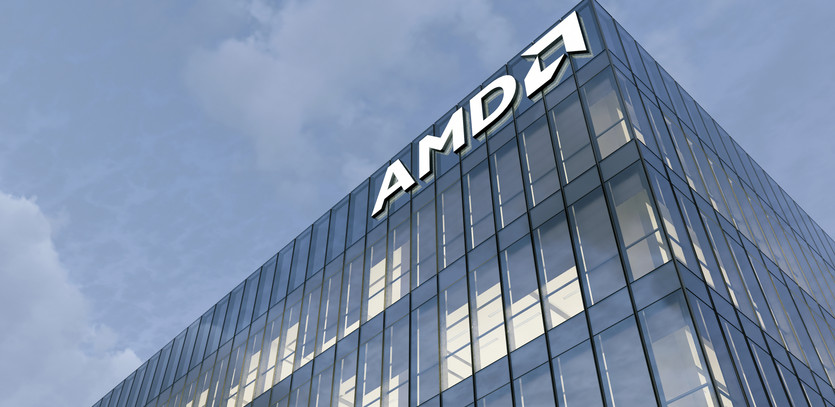Welcome to an engaging deep dive into Advanced Micro Devices Inc. (AMD), a titan in the world of semiconductor technology. A strong contender in the global arena, AMD is celebrated for its innovative designs and world-class technological solutions. Here's what you need to know about AMD:
1. The Core of AMD: At its heart, AMD is a semiconductor powerhouse with a worldwide clientele. From the intricacies of microprocessors (CPUs) and graphics processing units (GPUs) to the complexities of server and embedded processors, AMD masters them all. In addition, they're renowned for their semi-custom system-on-chip (SoC) products and cutting-edge technology for gaming consoles.
2. An Intellectual Property Giant: AMD is not just about manufacturing tech products. The company offers development services and is often seen selling or licensing portions of its intellectual property portfolio. The diversified approach adds another dimension to AMD's operations, setting it apart from its competitors.
3. AMD's Tech Mission: AMD has a clear aim: to offer high-performance computing capabilities that cater to the needs of modern, technologically advanced sectors. From 5G and communication infrastructure to AI, analytics, gaming, and cloud computing, AMD's products touch almost every aspect of contemporary digital life.
The journey with AMD promises to be exciting, shedding light on how this semiconductor behemoth continues to shape the tech industry. Stay tuned for more insights on AMD's historical journey, current operations, strategic developments, and much more.
The Evolution of AMD: From Silicon Valley Startup to Semiconductor Behemoth
The rise of Advanced Micro Devices Inc. (AMD) from a Silicon Valley startup to a global semiconductor giant is a compelling story of innovation, growth, and strategic transformation. Let's chronologically unravel AMD's journey:
1. The Genesis (1969): A band of eight pioneers, including Jeremiah Sanders, joined forces to create AMD, a venture committed to driving advancements in the semiconductor industry. This venture was imbued with a spirit of innovation, a trait that continues to define AMD today.
2. Stepping into the Market (1970): Just a year after its inception, AMD introduced its first product, demonstrating an ability to rapidly translate ideas into tangible goods.
3. Going Public (1972): A mere three years post-establishment, AMD solidified its business footing by going public on Sept. 27, 1972, thus initiating its journey as a publicly-traded company.
4. Diversification into Computer Chips (Mid-1970s): Not content with early successes, AMD started manufacturing computer chips during the mid-1970s, carving out a niche as a second-source chip manufacturer.
5. The Game-Changing Split (2008): A watershed moment in AMD's history occurred in 2008 when the company bifurcated into two distinct entities:
-
AMD: The one half retained the original name, refining its focus on the design of microprocessors.
-
GlobalFoundries Inc.: The other half spun off to become GlobalFoundries Inc., taking on the capital-intensive task of chip fabrication.
This smart strategic move allowed each entity to specialize, optimize, and excel in their respective domains.
Today, AMD stands as a testament to its founders' vision, continuing to push the frontiers of the semiconductor industry. Through strategic growth and persistent innovation, AMD has etched its name as a formidable player in the high-performance computing world.
AMD's Current Operations and Market Position
AMD today is an industry titan in the semiconductor sector, shaping the future of high-performance computing. The company's operations span across various markets:
1. Data Center Market: AMD designs and crafts top-tier semiconductor products that power the digital infrastructure of data centers, where they handle enormous quantities of data and facilitate complex computational tasks.
2. Personal Computer (PC) Market: With a strong foothold in the PC market, AMD's processors are a go-to choice for millions of users, enabling them to execute everyday computing tasks with ease and efficiency.
3. Gaming Market: In the gaming industry, AMD's graphic processing units (GPUs) and semi-custom SoC products breathe life into the most demanding games, offering players immersive experiences and crystal-clear graphics.
Based in Santa Clara, California, AMD operates under the steady leadership of its CEO and Chairperson, Dr. Lisa Su. The company's success in the previous fiscal year testifies to its robust financial health and operational efficiency. With a net income of $3.2 billion from a revenue of $16.4 billion in FY 2021, AMD is geared up to maintain its strong growth trajectory.
However, the journey isn't without competition. AMD operates in a fiercely competitive environment with significant players, such as Intel Corp. (INTC) and NVIDIA Corp. (NVDA), keeping the pressure high. These companies form the main rivals, constantly pushing AMD to innovate and outperform.
Key Market Achievements:
- AMD's high-performance products cater to the demanding needs of the 5G and communication infrastructure, AI and analytics, gaming, and cloud computing sectors.
- Despite the competitive landscape, AMD recorded impressive earnings of $3.2 billion on a revenue of $16.4 billion in FY 2021, demonstrating its capacity for growth and profitability.
AMD's current operations and market position are a testament to its agility, foresight, and commitment to innovation. With strategic acquisitions and technological advancements, it continues to solidify its place in the tech world and adapt to the ever-evolving landscape of high-performance computing.
AMD's Recent Developments and Strategic Acquisitions
In an ever-evolving technological landscape, AMD has consistently managed to stay ahead of the curve through significant advancements and judicious acquisitions. Here's a rundown of the company's notable recent developments:
1. Chrome OS Specific Processors (May 13, 2022): AMD made waves in the tech world with the launch of a new line of processors tailored specifically for Chrome OS, a move aimed at optimizing performance in devices running on Google's operating system.
2. Acquisition of Pensando Systems (April 4, 2022): In a strategic push to augment its high-performance technology portfolio, AMD announced the acquisition of Pensando Systems for a sum of around $1.9 billion. This company brings to the table:
- A distributed services platform that offers cloud infrastructure services.
- An addition to AMD's existing line-up of CPUs, GPUs, field programmable gate array (FPGA), and SoC solutions.
3. Share Repurchase Program (Feb. 24, 2022): As a testament to its robust financial health, AMD announced a new $8 billion share repurchase program, supplementing the $4 billion share buyback program from May 2021.
4. Xilinx Acquisition Completion (Feb. 14, 2022): AMD successfully completed the acquisition of Xilinx, a semiconductor company known as the inventor of FPGA and Adaptive SoCs, in a massive deal valued at around $50 billion. This strategic acquisition:
- Bolsters AMD's technological portfolio with FPGAs that can be reprogrammed post-manufacturing to deliver specific functionality.
- Increases AMD's competitiveness in the tech market by leveraging Xilinx's semiconductor capabilities.
Through these significant developments and strategic acquisitions, AMD continues to reinforce its commitment to spearheading high-performance computing, positioning itself as a leader in the global semiconductor industry.
AMD's Response to Global Chip Shortage and Other Challenges
Navigating the tumultuous waters of the global chip shortage, AMD has demonstrated resilience and strategic foresight. Here's an overview of how AMD has been handling these industry-wide challenges:
1. The Global Chip Shortage and Supply Chain Struggles: The COVID-19 pandemic brought about unprecedented disruptions in supply chains, sparking a global chip shortage. Products ranging from video game consoles to automobiles became increasingly difficult to obtain due to their embedded chip components. AMD's strategy to weather this storm has been twofold:
-
Forecasting and Advanced Focus: AMD has been able to steer clear of the majority of shortage-related issues by predicting demand trends years in advance. Furthermore, the company shifted its focus to more advanced chips, which were less affected by the shortage compared to mass-produced older types of chips.
-
Market Share Acquisition: Despite these challenges, AMD has successfully claimed some of the market share from Intel in the PC and server markets.
2. Industry Disruptions and Trade Conflicts: Other industry disruptions like the fire incident at Renesas Electronics Corp.'s factory and the ongoing U.S.-China trade war have put added strain on the supply of chips. Despite these setbacks, AMD's strategy has been one of anticipation and adaptation, helping them maintain a steady course.
3. CEO Dr. Lisa Su's Projections: Following the Xilinx acquisition, Dr. Su shared her outlook for the industry. She forecasted that global chip supplies would remain tight in the first half of 2022, but that the situation should improve in the second half. She emphasized the importance of working closely with AMD's customers, planning with them over multi-quarter and multi-year time horizons to optimize supply chain efficiency. The Xilinx acquisition further solidifies AMD's position as a major player in the industry, guaranteeing the company's fair share of capacity and support.
By confronting these industry-wide challenges head-on and leveraging strategic planning, AMD has successfully navigated the choppy waters of the global chip shortage, proving its resilience and industry acumen.
AMD's Leadership and Growth Prospects
Behind AMD's remarkable success and growth trajectory, there's a team of visionary leaders and a clear roadmap for the future. Here are the key points you need to know about the company's leadership and growth prospects:
1. The Captain at the Helm - Dr. Lisa Su: At the forefront of AMD's leadership is Dr. Lisa Su, the CEO and Chairperson of the company. With a track record that includes roles as Chief Operating Officer (COO) and senior vice president, Dr. Su's profound expertise and insightful leadership have been pivotal in guiding AMD's strategic direction.
2. The Company's Growth Strategy - Stock Splits and Share Ownership:
-
Historical Stock Splits: AMD has split its stock six times throughout its history, demonstrating the company's progressive growth and adaptability.
-
Major Shareholders: As of April 15, 2022, The Vanguard Group Inc. holds the lion's share of AMD's stock, owning approximately 137.2 million shares or 8.4% of the total shares outstanding.
3. Dividend Policies and Future Plans: AMD's growth-oriented strategies have seen the company focusing on reinvestment rather than offering dividends. This approach underscores the company's commitment to fostering technological advancements and fueling further expansion.
4. AMD's Status as an American Company: Proudly rooted in the U.S., AMD stands as a testament to American technological innovation. With its origin in Silicon Valley and current headquarters in Santa Clara, California, the company continues to make significant contributions to the national and global technology sectors.
In conclusion, AMD's strong leadership, coupled with its commitment to growth and strategic foresight, positions the company for a promising future in the ever-evolving global semiconductor industry.





